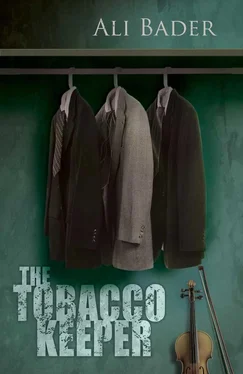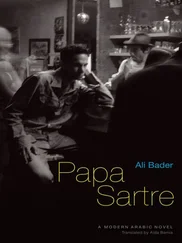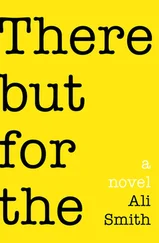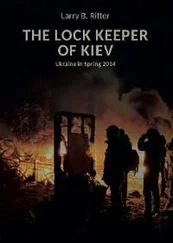In a letter to Farida, he said: ‘Pari’s body tells me that the world is infinitely large. Every time I stand in front of her, I see the huge mountains behind her and the stars sparkling in the pitch darkness of the night. I feel an infinite power residing within this living flesh. What exactly do I want from her? Why am I so fearful, so hesitant? I don’t really know what to do.’
During this period, he began taking delightful strolls around Tehran with Pari to the very same places he’d visited with Tahira thirty years earlier. As they wandered through Revolution Avenue or Azadi, he noted the great transformations of post-revolutionary Tehran. The poor south was dominated by religion and the chador, while the north was full of grand houses and large stores playing all kinds of songs and music. In the north, women went about unveiled and discussions were free. Pari would carry a scarf in her bag, which she put on when in the south and took off when in the north. But with the coming of winter the weather was changing fast. Haidar Salman smelt the cold humidity of the earth when he stood with Pari on Azadi Square. He knew that the war with Iraq had taken a new turn. Mobilization and the boosting of morale went on relentlessly. Clerics gave sermons from pulpits with machine guns slung over their shoulders. He felt that a huge explosion was bound to happen. It was as certain as death. In his mind’s eye he could see angry crowds sweeping over the squares. Once again the incensed, raging masses would go on the onslaught. The revolution, he thought, had turned the people into mobs. Distinctions of class had disappeared and easily manipulated groups had emerged onto the scene. The mob would march and burn and destroy with a blind, random force that knew no bounds.
The streets were damp, the trees bare and the houses miserable behind their rusty fences. At the back of the three-storey stores, beyond the stone-arched entrances and through a swirl of fog, were little yards with small recesses, old pigeon towers and tables fixed to the ground beneath ageing linden trees.
Haidar felt that things in Tehran couldn’t go on like this, for there were huge campaigns against the liberals. A secret war was being waged against music, the cinema and unveiled women. He witnessed the burning of cinemas and the banning of free discussion. One day, he was standing with Pari on Wali al-Asr Street, looking at the buildings shrouded in fog. He didn’t want to go to a café, but found his attention caught by a sudden mythical apparition: a girl wearing a blue shirt, leather jacket and jeans was selling newspapers. Around her stood a group of young men and women. They started to engage in a free discussion or what was called an ‘Azadi debate’. Haidar turned to Pari and told her that such scenes would not continue for long. Groups of bearded peasants from the countryside were carrying truncheons and breaking up leftist demonstrations. They would use stones to disperse any group of young people. He wrote to Farida: ‘With the support of the authorities, the militias have begun hounding women on Tehran’s streets, especially in the north. It’s a maddening, infuriating sight. The bearded scum of society are pursuing girls and women with the claim that their veil is “incorrect”. These riffraff shove the women, attack them with abusive words and bundle them into cars.’
As I told Faris Hassan in Tehran, I firmly believe that at that time Haidar Salman was beginning seriously to plan his escape from Tehran and once again head to Baghdad, either via Syria or Turkey. This was confirmed by Dr Khisro too. Haidar’s decision came from observing the huge changes that were taking place in Iranian society and the political programme of the revolution. He thought seriously of forging papers in order to get to Baghdad. But the questions that now pose themselves are: Who was Hassan Qazlaji? Who was Farrah Nikdahar? And how did they help him escape to Syria and from there to Baghdad?
I met Dr Khisro at the Naderi café, the same place where Iraqi leftists had met to plan their revolution and which Haidar Salman and Hekmat Aziz frequented. Dr Khisro told me that after his return from Bulgaria, Hassan Qazlaji had seen Haidar Salman by chance in this café. By then, Qazlaji had become an elderly, grey-haired man with glasses. He recognized Haidar Salman immediately, and screamed out loud, ‘You’re the famous musician Haidar Salman!’ He embraced Haidar and asked, ‘What’s happened to you? Look at your beard and your shabby clothes! What are you doing here, Maestro?’
Hassan Qazlaji was a Kurdish man who took part in the political struggle against the despotic rule of Reza Khan. After the downfall of Reza Khan in the early forties, following the invasion of Iran by British, Soviet and US forces, he established with a group of young revolutionaries the Komeleh Party, an anti-Fascist, Kurdish nationalist group. The party was later joined by Qazi Mohammad, the leader of the Republic of Mahabad, which was declared in 1945 but collapsed in 1946. Qazlaji was one of the founders and leaders of the party. After the fall of the Republic of Mahabad, however, Qazlaji fled to Iraq, where he published the Regay newspaper. He remained in hiding in Iraq, doing various jobs at restaurants, cafés and tobacco farms. He worked in the business of dying shoes and as a photographer in Sulaymaniyah in order to keep body and soul together. He was then arrested in Iraq and sent to jail, from which he was freed only after the 1958 Qasim revolution. He stayed for a while in Baghdad, and was introduced to Haidar at the house of his friend Hekmat Aziz. He then immigrated to Bulgaria, and after the success of the Iranian revolution in 1979, returned to Iran to take charge of the Kurdish edition of Mardom , the mouthpiece of the Tudeh Party of Iran.
Haidar Salman stopped in front of him and said: ‘Would you help me?’
‘Of course, Maestro!’
‘I’d like to escape to Syria!’
‘Consider it done,’ he told him.
Haidar Salman waited for the signal from Hassan Qazlaji. Pari knew nothing of the matter, nor did Mohammad Taqi or anybody else. Qazlaji insisted that the matter remain a closely guarded secret. Otherwise, the Pasdar (the revolutionary guard) would surely kill Haidar Salman. To vary his daily routine, Haidar stopped going to Naderi café and started a new itinerary. Every morning he would walk from Azadi Square to Khurasan Square, and then take the bus to the bazaar, where Mohammad Taqi and his friend Mirza Tabrizi sat at a small café.
Mohammad Taqi sat reading the morning papers and drinking his tea, while Haidar Salman sat facing him reading a biography in Persian, translated from the Russian, of the composer Tchaikovsky. Next to Mohammad Taqi was his friend Mirza Tabrizi, a merchant from Tabriz who’d been a farmer living off the pistachio trade, but who, after the revolution, had become a great merchant. Tabrizi naturally supported the clerics. Every time the two friends met, a heated political discussion took place. Mohammad Taqi adjusted his collar as he spoke; he wore thick glasses and his grey hair gave him a dignified look; when he coughed, his dry voice was sharp and raucous.
Haidar realized then that the liberals constituted a huge force in Iran. They were supported by President Abulhassan Banisadr and his intellectual ally, Engineer Mehdi Bazargan, the leader of the Nehzat-e Azadi movement, as well as his team at the Shura Council in coalition with the members of the nationalist Melli Front. He saw that they were supported by the largest organized popular and political opposition force on the streets. This was no less than the Iranian Mujahideen Khalq Organization, under the leadership of Massoud Rajavi. It was also supported by the Democratic Party of Iranian Kurdistan and the Fida-e Khalq Organization as well as other leftist organizations such as Al-Kifah, Al-Kadehin and Komeleh.
Читать дальше












